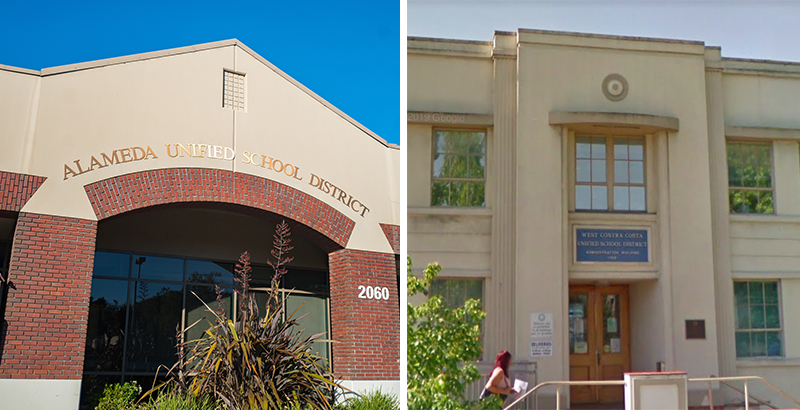As L.A. Voters Go to the Polls on $500M Annual Parcel Tax, Lessons Learned From Two Other California School Districts That Approved Theirs Years Ago

This article was produced in partnership with LA School Report.
If L.A. Unified’s proposed $500 million annual parcel tax passes Tuesday, it would be uncharted territory for the country’s second-largest school district.
L.A. Unified has never had a parcel tax. They aren’t commonplace, with about 9 percent of school districts in the state — most clustered in the Bay Area — successfully passing or renewing parcel taxes in the past five years. Parcel taxes are unique to California, and can serve as a fallback for cash-strapped districts that aren’t getting enough funding from the state.
The proposed tax, known as Measure EE, would charge residents within L.A. Unified’s boundaries 16 cents per square foot of developed property annually. Measure EE is estimated to cost most homeowners between $100 and $450 per year, while placing the largest tax burden on businesses and corporations.
Revenue from the tax would help pay for the $840 million contract that L.A. Unified agreed to after January’s teacher strike. And while the tax language doesn’t include relief for crippling employee pension and health care liabilities, new revenue could ease some of the fiscal pressure on the district, which is burdened by deficit spending and faces the threat of a county takeover if it can’t rightsize its budget. But the parcel tax’s passage is far from guaranteed. There’s been debate over whether the tax language is clear enough about its promised uses, and opponents are unconvinced that there will be sufficient accountability over how the money is spent and robust oversight guiding the entire process.
Insight into whether parcel taxes are the revenue cure school districts hope for can be gleaned from two other districts — Alameda Unified and West Contra Costa Unified — whose taxes are similar to the one L.A. Unified would levy. In one district, residents say the tax saved essential school programs from being gutted. The other district’s experience is more mixed, with some residents claiming that mismanagement and minimal oversight have corroded public trust around the tax initiative. Here’s what happened:
Alameda Unified
Alameda Unified’s 32-cent-per-square-foot parcel tax has been “the best of the worst we could hope” for since it first passed in 2011, district parent Sarah Olaes said. It’s staved off cuts to student services, though it doesn’t add extra frills.
The district, which sits on an island in the San Francisco Bay, enrolls about 9,600 students. Its parcel tax generates about $12 million annually for schools — 3 percent of that for local charters — making it Alameda Unified’s second-largest revenue source. It equates to $575 a year on average for residential properties, according to the district.
There is a maximum cap of $7,999 per parcel. It has survived two separate legal challenges.
The tax wasn’t meant to expand school offerings. Rather, it safeguarded basic line items as the district faced “pretty drastic” cuts after the 2008 recession, district spokeswoman Susan Davis said. High school sports, elementary music classes, some AP courses and five instructional days were on the chopping block. Three elementary schools were at risk of closure. The district was also looking at a possible 32-to-1 student-teacher ratio in grades K-3, Olaes said.
Funding “is never enough, but [the tax] stopped these terrible cuts from happening, which would’ve made a huge difference to the quality of [my kids’ education],” said Olaes, who has a seventh-grader and a senior in the district and has been heavily involved in campaigns for the tax.
The extra funds have kept those elementary schools’ doors open and preserved programming, the district confirmed. Class sizes for K-3 do not exceed the maximum 25-to-1 ratio. Sports teams are getting their uniforms and football helmets, balls and nets.
Because educational programs “are run by people,” Davis said, “the vast majority” of the revenue, about 93 percent, goes toward paying employee salaries and benefits. That’s not explicitly clear in the tax language, which lists 11 categories and respective percentage breakdowns for how the money should be allocated.
Paying for salaries is different from raises, though, Alameda Education Association President Judith Klinger said.
“We don’t pass parcel taxes to try and increase salary; it’s really more just to keep the doors open,” Klinger said, adding, “If you care about public education, you’ve got to pay for it.”
The district refrained from weighing in on how the tax has translated to academic gains, if at all.
Voters renewed the tax in 2016 with a nearly 75 percent approval margin. The tax, currently running from 2018 to 2025, “sailed through,” said Carrie Hahnel, who chairs the parcel tax oversight committee and also works for the advocacy nonprofit The Education Trust–West. Residents “can see the direct connection between their investment and the services.”
It isn’t a silver bullet, however. Like other districts, Alameda Unified is struggling to support a growing population of special education students and cover rising pension costs. The district’s roughly 550 teachers — who won a 4.5 percent raise this year — remain among the lowest-paid in Alameda County, with a starting salary of about $52,000. Alameda Unified in 2017-18 also approved more than $3.5 million in budget cuts, including rolling back extended kindergarten hours and inching high school class sizes closer to the 35-to-1 maximum student-teacher ratio.
The district posts annual staff and oversight committee reports on parcel tax revenue and expenditures. Hahnel described the relationship between the 10-member committee and the district as “very healthy and positive.” But she acknowledged that the committee’s role “is minimal.” Oversight committees like the one in Alameda are not mandated by state law for parcel taxes.
“We don’t actually perform audits, we have not visited the school sites,” Hahnel said. “… I can ask a lot of questions, and I can get answers. And [district officials] do feel accountable to provide answers. But they don’t necessarily feel compelled to change what they’re doing as a result.”
West Contra Costa Unified
West Contra Costa Unified’s parcel tax was harder to review. The district did not follow through on seven interview requests made by LA School Report. A few district residents interviewed, however, said that the funds are mismanaged and that oversight is lackluster.
West Contra Costa Unified, which serves about 28,000 district students in the East Bay area, passed the first iteration of its 7.2-cents-per-square-foot parcel tax in 2004. There have been three approved renewals since, with the latest version in effect from July through 2027. The tax generates about $9.7 million a year, with a $108 average tax bill for a 1,500-square-foot property. Since 2016, a growing portion of the revenue — 12.6 percent as of January — is designated for local charters.
The district became synonymous with financial hardship after becoming the first school system to be taken over by the state after declaring bankruptcy in 1991 (it resumed control after paying off its debts in 2012). Since then, it continues to combat “declining enrollment, increased contributions to [retiree benefits] and other benefits, and growing special education expenses,” district spokesman Marcus Walton wrote in an email.
The current tax’s stated purpose is to “improve” the quality of education by protecting core academics, preparing students for college and the workforce and providing smaller class sizes, among other things. That’s translated to most of the tax revenue — three-quarters of this year’s $9.7 million, for example — going toward salaries and benefits for employees, such as athletic coaches, librarians and counselors. Teachers last year won a 15 percent raise by 2020; Walton wrote that the raises “were not dependent on the parcel tax revenue” but that tax revenue “technically” can go toward the cost.
United Teachers of Richmond President Demetrio Gonzalez, who advocated for the parcel tax’s renewal in 2016, said the district’s commitment to funding librarians and counselors is essential. “We’re seeing in large urban settings like Richmond and L.A. that we’re in very large need of supportive staff,” he said. Gonzalez added that he does wish “we could increase the [tax] amount and put in more to things like the class sizes piece, or community schools” — two areas he says the parcel tax isn’t covering currently.
Parent Erin Moody, whose daughter is a sophomore who transferred to a local charter school, is frustrated that she hasn’t seen improvements in the classrooms. She described the district as poorly run, repeatedly “coming to the well” for taxpayer money.
“A lot of us are tired of money getting misspent,” Moody said. She added that West Contra Costa Unified has mismanaged its numerous school construction bonds as well, further eroding trust. But she still voted for the latest parcel tax.
“What do you say? That you don’t want the children to have the money?” she said. “It’s very upsetting.”
Another point of concern is a seeming lack of oversight. The district’s now nine-member oversight committee “was on hiatus most of 2017-18 at the request of the Board,” Walton wrote. Prior to that, he added, “the committee was unable to reach a quorum in order to conduct business” — which helps explain the absence of annual reports on the school district’s website. Walton noted that a report covering 2016-18 is anticipated in June.
The oversight committee’s job is often “frustrating” and “thankless,” said Susan Pricco, a Contra Costa Taxpayers Association board member who said she’s seen the school board ignore correspondence from the oversight committee.
While Gonzalez, the union head, said he agrees that “we can do a better job at holding the district accountable,” he added that charters, which don’t fall under the district’s purview, “need to be equally transparent.” Oversight committee meeting minutes from November revealed that none of the charters that received parcel tax revenue in 2016 and 2017 submitted audit reports “with the required schedule.” Walton wrote in an email that audits have since been “completed and submitted” — conflicting with Gonzalez saying that it’s an ongoing issue.
There is no “one answer” to making things right, Pricco said. But she was clear on this point: “We want to support our students. We want to support our teachers. But don’t screw around with our tax money.”
That sentiment is almost certainly shared by L.A. Unified taxpayers, who soundly rejected the district’s earlier attempt to pass a parcel tax in 2010. Whether they have been persuaded in 2019 to see the tax as more of a benefit than a burden will be clear by tomorrow, when two-thirds of voters will have to vote “yes” in order for it to pass.
Polls in L.A. Unified are open 7 a.m. to 8 p.m. on Tuesday. To find your polling location and other voter resources, click here. For more coverage of L.A.’s proposed tax, see here:
● June’s Parcel Tax to Fund Schools Takes Center Stage After Jackie Goldberg’s LAUSD Board Win
Get stories like these delivered straight to your inbox. Sign up for The 74 Newsletter

;)
